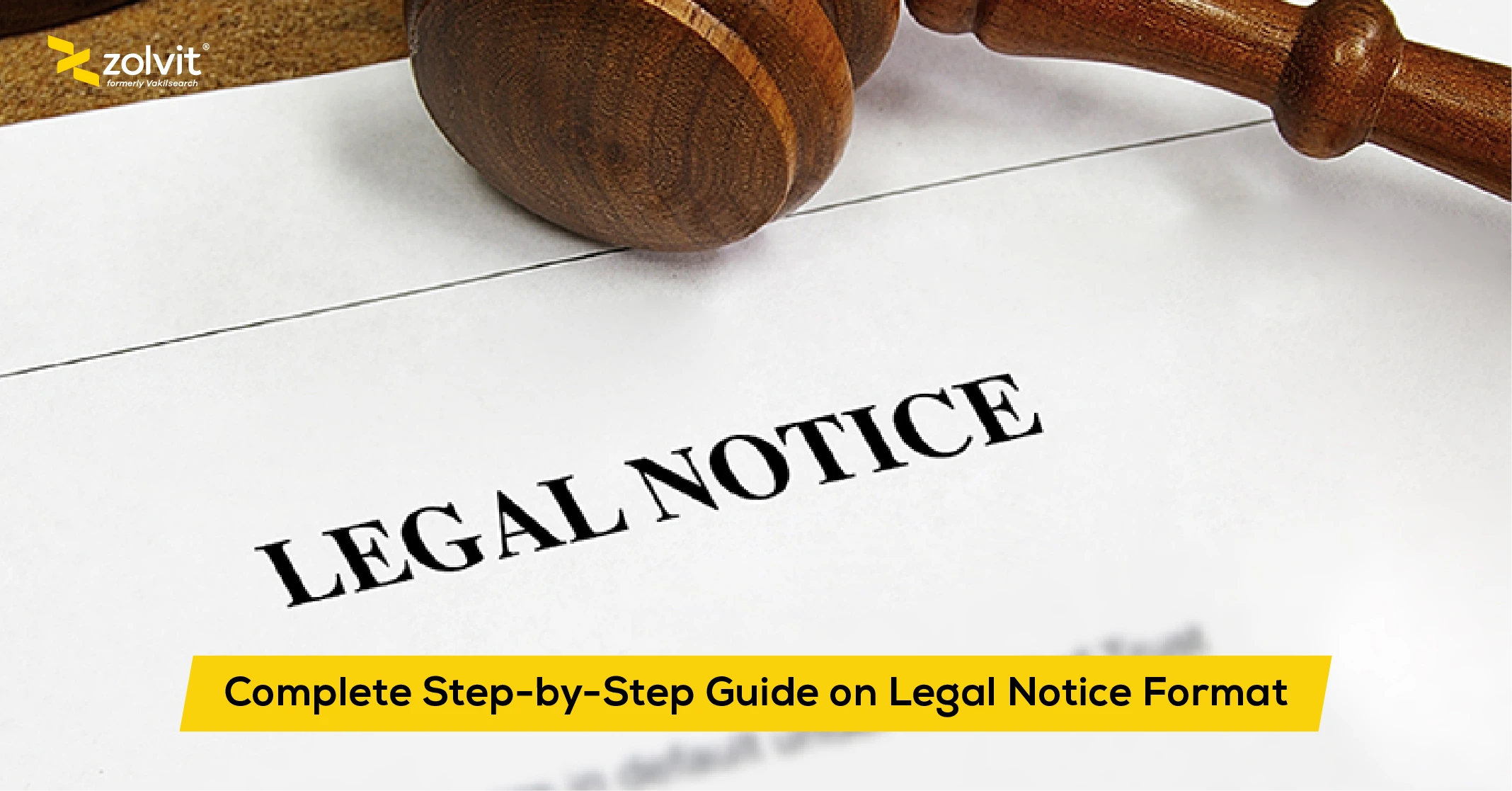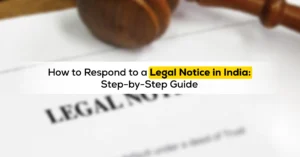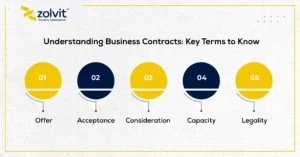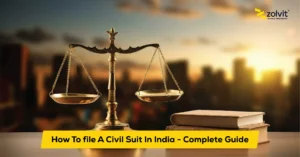A legal notice is a formal pre-litigation notice and legal document issued by one party to another communicating a grievance or threat of legal action. A legal notice usually has a formal notice format, detailing the issue, applicable legal provisions, and relief sought. This type of legal communication is employed in cases of contract violations, disputes over property, and consumer grievances so that the recipient knows of the allegations against him and has an opportunity to respond or resolve the matter amicably.
In this blog you will learn in detail about the legal notice, importance of legal notice format, essential components of legal notice format, step by step process to draft a legal notice, different formats of legal notice for different issues, sample legal notice formats, key takeaways and frequently asked questions.
What is Legal Notice?
A legal notice is a formal document sent to communicate a grievance or threat of legal action, outlining the issue, applicable laws, and relief sought. It provides the recipient an opportunity to respond or resolve the matter before court proceedings begin.
Step-by-Step Guide to Drafting a Legal Notice
Drafting a legal notice is an important step in resolving disputes or enforcing legal rights. Here is a 5 simple steps that will walk you through the process of creating a clear, professional legal notice, ensuring that all essential elements are included for it to be effective and legally binding:
Step 1: Consult a Legal Expert
Having professional help from a lawyer is paramount before sending legal notice. A legal consultation makes the notice legally valid, making it more effective. Expert assistance can help in finding applicable legal provisions and making the case stronger.
Step 2: Gather Necessary Information
It is important to collect all required documents, facts, and evidence for the preparation of a good notice. Authenticating documents like agreements, contracts, or records of transactions gives supporting proof. Proper verification of the required information is important in presenting a cogent argument.
Step 3: Draft the Notice Using Proper Format
A notice must be drafted in a proper template with the right formatting and structure. The draft must have the sender’s information, subject, grievance, legal grounds, and relief claimed. Properly structured notice increases clarity and adheres to legal standards.
Step 4: Review the Draft for Accuracy
Prior to sending the notice, proofreading is imperative to verify facts and correct if necessary. Error-free drafting enhances credibility, whereas legal accuracy averts misinterpretation or dismissal of the notice.
Step 5: Serve the Notice to the Opposite Party
The last step is to formally send the legal notice through a trusted means like registered post or courier with proof of acknowledgement of receipt. Due notice service is necessary because it serves as evidence of communication and strengthens the case if legal action is initiated.
Sample Legal Notice Format
Here is an outline of the key elements and structure, helping ensure that the notice is professionally written and legally sound:
| ADVOCATE OFFICE Address_________Contact No.: ______________ Email:_________________
Ref. No._____ Dated:___________ REGISTERED A.D. LEGAL NOTICE To, (Name and Address of the Recipient.) ______ Son of _____ Resident of ______________ Sir, Having instructions from and on behalf of my client _____ son of _____R/o _____, I do hereby serve you with the following legal notice:
I, therefore, through this legal notice, call upon you to pay the due amount of rent _____/- along maintenance charges and interest and vacate the premises of my client immediately, within _____ days from the date of receipt of this legal notice. (Relief demanded by the Plaintiff). In case you fail to do so, then my client has given me clear instructions to file legal proceedings against you in the competent court of law under the provisions of the Indian Contract Act and other applicable laws. In that event you shall be fully responsible for all costs, risks and responsibilities. (Legal basis). A copy of this legal notice is retained in my office for record and further necessary action. Advocate. |
Importance of a Proper Legal Notice Format
A properly designed legal notice template is essential for the purpose of ensuring legal compliance, formal significance and the validity of the notice.
- A properly designed legal notice template ensures legal compliance, formal significance, and validity
- A poorly written notice cannot be enforced in court, highlighting the importance of a correct format
- A well-designed legal notice includes necessary information such as sender details, recipient information, grievance description, and legal basis
- Following the correct format minimizes misinterpretation and enhances clarity
- Proper compliance with the format improves the notice’s validity, aids dispute resolution, and increases the likelihood of success in court.
Essential Components of a Legal Notice Format
A legal notice must include key components to ensure its effectiveness and legal validity. Here is a detailed outline of the same:
Sender and Receiver Details
A legal notice should include in clear terms the name, address, and identification of both the sender and recipient. Sender details guarantee authenticity, while correct recipient details ensure the notice reaches the intended recipient. This section confirms the formal communication between both parties and sets the stage for legal correspondence.
Subject of the Legal Notice
The topic of the notice should articulate its definite purpose concisely yet informatively. It has to briefly state the legal claim that is being made while retaining subject clarity so as not to be misinterpreted. A properly established notice helps the receiver in comprehending the gravity of the issue at first glance.
Description of the Facts and Issues
This part offers a factual account of the grievance, event details, an incident chronology, and pertinent legal grounds. The presentation of the incident details in a clear manner assists in the determination of the basis of the claim and illustrates why the sender is requesting legal redress. Accuracy and precision are crucial in ensuring that the notice carries substance.
Specific Relief or Remedy Sought
A legal notice should state the requirements placed by the sender, such as the remedy or legal relief sought. Whether it is financial compensation, fulfillment of a contract, or any other relief, this section outlines the details of the claim and the redressal action to be taken by the recipient.
Warning of Legal Action in Case of Non-Compliance
A legal notice usually ends with a legal action threat in case the recipient does not respond or comply. This paragraph summarises the repercussions, e.g., the possibility of a lawsuit or further action on the issue. The inclusion of non-compliance consequences conveys to the recipient the seriousness of the issue and the legal implications.
Common Mistakes to Avoid When Drafting a Legal Notice
When drafting a legal notice, it’s important to avoid common mistakes that could undermine its effectiveness. Identifying and addressing these errors ensures that your notice is clear, professional, and legally sound. Here is a list of the common mistakes to avoid:
- Incomplete or Incorrect Information: Providing wrong sender/recipient details, case facts, or dates invalidates the notice. Accurate information ensures legal credibility and enforceability
- Drafting Mistakes: Weak grammar, spelling errors, or incorrect legal terminology weaken the notice. Proper drafting with accurate language enhances clarity and seriousness
- Usage of Ambiguous Language: Ambiguity can lead to misunderstandings, reducing the notice’s effectiveness. Clear definition of claims, facts, and legal grounds maximises communication and minimises controversy
- Omission of Key Facts: Missing legal provisions, evidence, or claims weakens the notice. A strong factual foundation, supported by documents, strengthens the case and increases the chance of success
- Non-Compliance with Legal Form: Ignoring the correct legal structure may lead to rejection. Following legal guidelines ensures clarity, enforceability, and appropriate response from the recipient.
Legal Notice Formats for Different Scenarios
Legal notices vary depending on the scenario, each requiring a specific format and tone. Understanding these variations helps ensure that the notice is appropriate and effective for the situation at hand. Here are some insights of the legal notice formats:
Format for Non-Payment of Dues
A notice for non-payment of dues is a legal request for due payments and describes the possible results in case the debt is not paid. A notice for non-payment of dues usually contains the following main items:
- Demand: A direct call for payment of the due sum
- Time Limit: A precise time limit within which the amount should be paid, usually 15 or 30 days
- Interest: A call for interest on the outstanding sum
- Consequences: A statement that legal proceedings will be instigated if the payment is not received
- Costs: An assurance that the recipient will absorb any costs derived from legal action.
Essential details to include on the notice are:
- Client Details: The address and name of the client
- Business Details: The name and type of client‘s business
- Transaction Details: The amount, date, and any invoices included in the transaction
- Payment History: A list of past payment requests and their responses
- Payment Options: Available forms of payment.
Format for Breach of Contract
A contract breach notice points to the breach of terms agreed on a contract and initiates a legal claim for resolution or compensation. It cites the breach of agreement, issues a call for redressal, and threatens legal repercussions if not redressed. A breach of contract legal notice should explicitly mention the following information:
- Parties: The addresses and names of all parties to the contract
- Contract: The name, date, and salient terms of the contract
- Breach: A specific description of the breach, indicating which clause was infringed
- Demand: What the defaulting party should do, including correcting the breach or paying compensation
- Time Limit: A predetermined time within which the defaulting party must take action or effect a correction
- Consequences: The measures to be taken should the breach fail to be settled within the stated time.
Format for Eviction Notice
A legal eviction notice should explicitly state the tenant’s circumstances, such as the reason for eviction and the time allowed to leave the premises. It should also state the action to be taken if the tenant does not obey. Contents of a legal eviction notice:
- Tenant’s Name: The tenant’s full legal name
- Property Address: The address of the rental property
- Reason for Eviction: The reasons for eviction, including non-payment of rent or violation of lease agreement
- Notice Period: The duration of days the tenant is required to leave the property, according to the lease agreement and laws
- Consequences: The effects of not leaving the property, including legal action and formal eviction.
Additional Information:
- The notice period is specified by the lease agreement and local legislation
- The tenant must be notified to return the keys, access cards, or any other property of the landlord
- A joint inspection of the property can be done prior to the tenant leaving
- This notice is a formal one and offers the tenant the chance to sort out the issue prior to proceeding with further legal action.
Format for Defamation
Legal notice for defamation is sent when false information is provided that harms the reputation of an individual. The notice must clearly state the defamatory statements, the injury caused, and request that the false allegations be withdrawn. It must also state the action if the issue is not resolved.
Contents of a legal notice for defamation:
- Sender’s Information: The sender’s name, address, and contact information
- Defamatory Statements: A concise description of the false statements, where and how they were made (e.g., social media, news sources)
- Damage to Reputation: A description of how the statements have damaged the sender’s reputation or caused other damage
- Demand for Retraction: A demand that the defamatory statements be retracted or corrected within a given time period (e.g., 15 or 30 days)
- Notice Period: The time within which the defamatory words are to be withdrawn or clarified
- Consequences: A warning that legal action, including a lawsuit for damages, will be taken if the issue is not addressed.
Other crucial Information include:
- The notice should request an apology or withdrawal to prevent further harm
- In certain situations, the notice might also seek compensation for damage arising from the defamation
- This notice acts as a verbal warning prior to commencing legal action for defamation, giving the offending party a chance to rectify the statements.
Conclusion
Zolvit’s expert lawyers specialise in drafting legally sound notices, ensuring they are clear, compliant, and enforceable. With our professional guidance, you can avoid drafting mistakes, omissions, and ambiguity, boosting the effectiveness of your notice. Trust Zolvit to ensure precision, improve your legal position, and enhance your chances of a successful outcome, preventing complications along the way. Let our legal experts handle your notice, so you can focus on resolving your dispute efficiently.
Key Takeaways
- A legal notice is a formal communication used to resolve disputes or inform someone about legal claims before taking further action
- A clear and structured legal notice format ensures the message is precise, professional, and legally valid
- Key elements like sender and recipient details, subject, demand, and consequences must be included for the notice to be effective
- Drafting a legal notice involves understanding the issue, clearly stating the demand, setting deadlines, and outlining consequences
- Legal notices vary depending on the issue, such as non-payment of dues, breach of contract, or defamation
- Sample legal notice formats are useful templates to follow and adapt to different scenarios
- Failing to draft a proper legal notice can impact the effectiveness of your case or claim in legal proceedings.
FAQs Related To Legal Notice Format
Is a legal notice mandatory before filing a case?
Yes, in certain cases, such as consumer disputes, contract breaches, and landlord-tenant issues, a legal notice is mandatory before filing a lawsuit. However, for criminal cases or urgent matters, it may not be required. Sending a legal notice helps in pre-litigation settlement and strengthens the sender’s legal position.
What should a legal notice include?
A legal notice should contain sender and recipient details, subject, description of facts, legal grounds, specific relief sought, and a deadline for response. It must be clear, precise, and legally structured, ensuring that the recipient understands the grievance and potential legal consequences of non-compliance.
Can I draft a legal notice without a lawyer?
Yes, an individual can draft a legal notice without a lawyer, but it is advisable to seek professional legal assistance to ensure accuracy and enforceability. A lawyer can help in structuring the notice, using appropriate legal terminology, and increasing the chances of a favorable resolution.
How is a legal notice served to the recipient?
A legal notice is typically served via registered post, courier, or email, ensuring proof of delivery. Some jurisdictions also allow service through official court channels or electronic means. Proper service is essential to establish that the recipient has received and acknowledged the notice.
What happens if a legal notice is ignored?
If a recipient ignores a legal notice, the sender may proceed with legal action. Ignoring a notice can lead to court proceedings, monetary penalties, or adverse judgments. Responding to a notice within the given timeframe is crucial to avoid unnecessary legal consequences.
Are there specific legal notice formats for different cases?
Yes, different legal matters require specific legal notice formats. Notices for non-payment of dues, breach of contract, eviction, defamation, and consumer complaints each follow a structured approach tailored to the nature of the legal dispute and applicable laws.
How long does a recipient have to respond to a legal notice?
The response time for a legal notice varies depending on the case type and jurisdiction, typically ranging from 7 to 30 days. The notice should clearly mention the deadline for response, after which the sender may proceed with further legal action.
Is a legal notice enforceable in court?
A legal notice itself is not legally binding but serves as pre-litigation evidence. If the dispute escalates, the notice can be used in court to demonstrate good faith efforts for resolution and support the sender’s legal claim.
Can a legal notice be withdrawn or amended after being served?
Yes, a legal notice can be withdrawn or amended before legal action is initiated. The sender must formally communicate the changes to the recipient. Modifications may be necessary due to new evidence, negotiations, or changes in legal strategy.
What should I do if I receive a legal notice?
Consult our Zolvit’s expert legal team. We'll help you understand the claims, draft a timely response, preserve key evidence, and explore options for settlement or mediation. With Zolvit, you’ll navigate legal challenges efficiently, ensuring your best interests are protected.
Related Case study:
How to Respond to a Legal Notice for an Unapproved Credit Note





